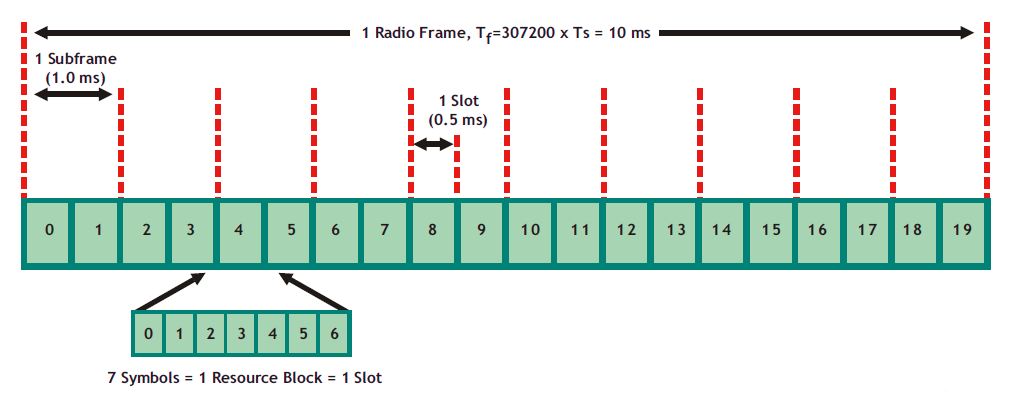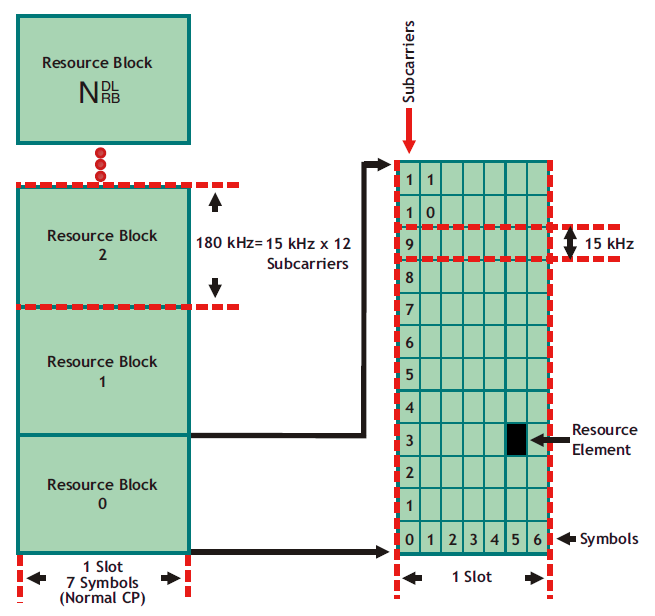The following document serves to provide a general introduction to how data rates are estimated in LTE. This article can help readers understand how 4G data speeds are calculated at a theoretical level. For the sake of clarity we will simplify and deal with arguably one of the most common LTE configurations, per the following:
- FDD LTE
- Default cyclic prefix
- PDCCH overhead = 1 per subframe
- UE Category 4 (150,752 TBB/TTI)
- 20 MHz channel
- 2x2 MIMO
LTE Physical Layer Recap
LTE employs OFDMA as it's base multiple access scheme, leveraging Orthogonal Frequency Division Multiplexing (OFDM). OFDM splits the carrier frequency bandwidth into several small subcarriers spaced at 15 kHz intervals, and modulates individual subcarriers using QPSK, 16-QAM, or 64-QAM modulation.
OFDMA then assigns each user the bandwidth needed for their transmission, using a scheduler such as Proportional Fair, Max C/I, Proportional Demand, etc. Unassigned subcarriers remain off, reducing power consumption and interference.
Modulation and Code Rate
Adaptive Modulation and Coding (AMC) is employed to encode data onto the subcarrier, whereby a digital modulation and code rate scheme is chosen dynamically based on channel conditions reported by the User Equipment (UE). When channel conditions are poor, due to high interference or low signal strength, a simpler scheme will be chosen, conversely when the channel is clean a more complex encoding can be chosen.
There are two components to AMC: digital modulation, and code rate.
Digital Modulation
A digital modulation scheme is simply a manner of encoding a number of information bits (i.e., binary zero or one) in each time period called a symbol, by varying amplitude and phase of the subcarrier wave. The symbol forms the indivisible building block from which all our calculations are based. Constellation diagrams are used to represent the possible amplitude and phase variations, which have been shown below.

Code Rate
Coding refers to a forward error-correction methodology in which the data stream is padded with additional bits to permit error detection and correction. A short Cyclic Redundancy Check (CRC) value is appended to data within each transport block, comprising of a polynomial hash of the data, which is checked for a match against a CRC hash of the received data. A Turbo Coding scheme (namely, PCCC) is used to provide duplication of the data to allow any detected errors to be corrected by the UE. For example, a code rate of 1/3 results in one bit being sent as three bits i.e., two duplicate copies for each bit of information.
As channel conditions improve, the code rate is adjusted so that more data is encoded with less duplication. Under very poor channel conditions, the code rate may drop as low as 1/12 (1 bit + 11 copies), and under clean channel conditions may reach as high as 11/12 (11 bits + 1 copied bit). The table below shows a typical modulation and coding scheme for LTE.
| Radio Bearer Index | Name | Modulation | Channel Coding Rate | Bearer Efficiency (bits/symbol) |
|---|---|---|---|---|
| 1 | QPSK 1/12 | QPSK | 0.0761719 | 0.1523 |
| 2 | QPSK 1/9 | QPSK | 0.117188 | 0.2344 |
| 3 | QPSK 1/6 | QPSK | 0.188477 | 0.377 |
| 4 | QPSK 1/3 | QPSK | 0.300781 | 0.6016 |
| 5 | QPSK 1/2 | QPSK | 0.438477 | 0.877 |
| 6 | QPSK 3/5 | QPSK | 0.587891 | 1.1758 |
| 7 | 16QAM 1/3 | 16QAM | 0.369141 | 1.4766 |
| 8 | 16QAM 1/2 | 16QAM | 0.478516 | 1.9141 |
| 9 | 16QAM 3/5 | 16QAM | 0.601563 | 2.4063 |
| 10 | 64QAM 1/2 | 64QAM | 0.455078 | 2.7305 |
| 11 | 64QAM 1/2 | 64QAM | 0.553711 | 3.3223 |
| 12 | 64QAM 3/5 | 64QAM | 0.650391 | 3.9023 |
| 13 | 64QAM 3/4 | 64QAM | 0.753906 | 4.5234 |
| 14 | 64QAM 5/6 | 64QAM | 0.852539 | 5.1152 |
| 15 | 64QAM 11/12 | 64QAM | 0.925781 | 5.5547 |
Frame Structures
In order to transition our calculations from being measured in bits per symbol into bits per second, we need to define the LTE radio frame. The radio frame is a key structure defining transmission time slots. An FDD LTE radio frame is 10 milliseconds in length, and is divided into 10 subframes of 1 millisecond, which are in turn divided into two slots of 0.5 milliseconds. Following these calculations, each radio frame is 20 slots in length, with each slot being 7 symbols in length, with each symbol being 0.071428 ms in length.
Using our newly defined frame structures, we can now see that for a single subcarrier we can transmit 7 x 2 x 10 = 140 symbols per radio frame, equalling 140 symbols x (1000 ms/s / 10 ms) = 14,000 symbols per second. Using the table above, the best possible bearer efficiency is 5.5547 bits per symbol = 77,765 bits per second per subcarrier.

Bandwidth Structures
We've now learnt how to calculate how many bits per second per subcarrier, but OFDM allows us to stack a number of subcarriers in a given channel width, so we need to now define our elementary symbol in terms of width. One symbol per one subcarrier forms the smallest structure in LTE, called the Resource Element (RE). This resource element can be thought of as having two dimensions - width (one subcarrier, 15 KHz), and length (one symbol, 0.071428 ms).
The next structure required to calculate data rate is a two dimensional block called the Resource Block (RB), which has a width of 12 subcarriers totalling 180 KHz, and length of seven symbols totalling 0.5 ms. A length of seven symbols has been chosen so that we can easily map one resource block equalling one slot in our radio frame.

Defining these two structures now allows us to reconcile LTE channel bandwidth, which we've defined in the beginning as a 20 MHz channel. If resource block is 180 kHz wide, we can fit 111 RBs in our 20 MHz wide channel. Unfortunately 20 MHz is our total channel width, edge to edge, including guard bands. Accordingly our usable channel width is reduced to 18 MHz, allowing the transmission of 100 RBs.
Control Channel Overheads
While it would be convenient to jump straight in to calculating our total data rate, overheads generated by other physical channels and signals must be removed. In the beginning we've defined our physical channel overhead to be 1x PDCCH symbol per 1 ms subframe, which leaves 13 data bearing symbols out of 14. This leaves 130 symbols per radio frame, or 13,000 symbols per second. Factoring in our modulation and coding efficiency of 5.5547 bits per symbol, we get a data rate of 72,211 bits per second.
In practice the number of allocated PDCCH symbols depends on the quantity of traffic loading the cell. We also have additional overheads from other channels, for example Downlink RS contributes a 4.72% overhead, and all other control channels (PSS, SSS, PBCH, PCFICH, PHICH) aggregate to a further 2.6% overhead.
2x2 MIMO
The use of two antennas in the downlink permits twice the number of subcarriers, one can think of 2x2 MIMO as doubling our useable spectrum provided the two spatial streams have low correlation - generally achieved by using orthogonal polarities. This increases our number of RBs from 1200 to 2400.
Calculations
In a 20 MHz channel we have 100 RBs, each 12 subcarriers in width, giving us 1200 subcarriers. 2x2 MIMO gives us 2400 sub carriers. Therefore our total calculation for a 20 MHz channel is 72,211 x 2400 = 173,306,640 b/s = 173.306 Mb/s at our highest possible modulation and coding scheme.
Device Limitations
Unfortunately the story doesn't end there, while the network may be capable of providing a given data rate, it does not guarantee the device is technically capable of receiving such a rate. A device's LTE category imposes a hard limit on the number of transport block bits (TBB) receivable in the one subframe interval (TTI). We have defined in this example the use of a Category 4 device, which has a limit of 150,752 TBB/TTI.
This calculation is significantly easier, since in our case the limit is below what the network can provide. 150,752 bits / 1 ms subframe results in a hard limit of 150.752 Mb/s.
Again this is a simplified example, 3GPP 36.213 Table 7.1.7.2.2-1 should be followed.
References
[1] ChienHua Wu, LTE DL Throughput Calculation, [Online], http://jianhuanote.blogspot.com.au/2015/03/lte-throughput-calculation.html
[2] 3GPP TSG, "Evolved Universal Terrestrial Radio Access (E-UTRA); Physical layer procedures", 3GPP, Valbonne, France, 3GPP TS 36.213 V14.1.0, Sept. 2016.
[3] ShareTechnote, Throughput Calculation Example - FDD, [Online], http://www.sharetechnote.com/html/Handbook_LTE_ThroughputCalculationExample.html
[4] ShareTechnote, CQI, [Online], http://www.sharetechnote.com/html/Handbook_LTE_CQI.html
[5] LTE University, How to calculate peak data rate in LTE, [Online], http://lteuniversity.com/get_trained/expert_opinion1/b/hongyanlei/archive/2010/02/18/how-to-calculate-peak-data-rate-in-lte.aspx
[6] Frank Rayal, LTE Peak Capacity Explained, [Online], http://frankrayal.com/2011/06/27/lte-peak-capacity/
[7] Radio-Electronics, LTE UE Category & Class Definitions, [Online], http://www.radio-electronics.com/info/cellulartelecomms/lte-long-term-evolution/ue-category-categories-classes.php
[8] 3GPP TSG, "Evolved Universal Terrestrial Radio Access (E-UTRA); User Equipment (UE) radio access capabilities", 3GPP, Valbonne, France, 3GPP TS 36.306 V14.1.0, Sept. 2016.